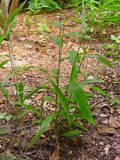Native Plants

Q. Who is Mr. Smarty Plants?
A: There are those who suspect Wildflower Center volunteers are the culpable and capable culprits. Yet, others think staff members play some, albeit small, role. You can torture us with your plant questions, but we will never reveal the Green Guru's secret identity.
Did you know you can access the Native Plant Information Network with your web-enabled smartphone?
Ask Mr. Smarty Plants is a free service provided by the staff and volunteers at the Lady Bird Johnson Wildflower Center.

rate this answer
Thursday - April 29, 2010
From: Whitehouse Station, NJ
Region: Northeast
Topic: Problem Plants, Grasses or Grass-like
Title: Aggressive native Inland Sea Oats in Whitehouse Station NJ
Answered by: Barbara Medford
QUESTION:
Can you direct me to a source of help managing a very aggressive grass, Chasmanthium latifolia, Woodland Oats or Indian Sea Oats. It is behaving like a very noxious plant and I am concerned as I am having trouble controlling it.ANSWER:
We are surprised to find someone wanting to get rid of Chasmanthium latifolium (Inland sea oats). In Texas, many gardeners love it, because it is one of the few grasses that really do well in shade, it looks good most seasons, and will virtually make a hedge with it's graceful stems and "oats" hanging over. However, everyone has their preferences and we will see what we can do to help you.
From Wayside Garden, we found this article Three Seasons of Showy Color for the Shade; they don't consider it invasive but several of the responders in Dave's Garden do. This Floridata site, Chasmanthium latifolium, conceded that it could be invasive if you had it in moist soil and sun, so that's at least a clue.
We found no one saying "This is a pest, and this is how to get rid of it," so we will have to do it. First, don't let it seed; in fact, keep it cut down very low. This can eventually starve it out, but it's a little slow. The roots are apparently fairly easy to transplant, so we're assuming they are also easy to dig out. If you have it growing in a garden situation, that is going to make it harder, because you may have to keep the soil moist for the garden plants, and don't want to disturb the other plant roots to dig up the grass roots. It can spread both by seeds and roots, you'll have to address it on both fronts. Since it is a grass, a member of the Poaceae family, you can purchase a weed killer for monocots, only; that is, grasses. When a plant has a good root system like this one does, it's difficult to get the herbicide to the roots. You might try cutting it down as much as you can, which eliminates seed, and then painting the stalks left in the ground with the herbicide and a small disposable paint brush. Be careful, though, your lawn is probably a grass, too, so we don't recommend spraying. Dig out as many of the roots as you can, and dispose of them where they won't regrow. You'll have to keep watching for it and grubbing it out as it comes up in the Spring.
From our Native Plant Image Gallery:
More Grasses or Grass-like Questions
Certified organic native grass seeds for Texas
August 10, 2014 - Thanks for your previous answer to my pasture grass seed question. We know about Native American Seed but they don't sell certified organic seeds. We're not sure whether we'll be able to find cer...
view the full question and answer
Control of invasive sandburs in Austin
May 05, 2014 - My attempts to control / eradicate Sanbur with pre-emergent corn gluten twice yeary for the last three years have been unsuccessful. My post emergent pulling weeds for 15 years has also been unsucces...
view the full question and answer
Source for Saltmarsh cordgrass from Houston
April 16, 2013 - I work for a consulting firm and we are looking to do more of our wetland creation/restoration. Do you know where one can purchased Spartina alterniflora?
view the full question and answer
Native grasses for chain link fenceline in Nash, TX
April 29, 2009 - I have chain link fence all the way around my yard and I am getting tired of having to weed eat along the fence line. I am looking for some type of year round decorative plant or grass (preferably on...
view the full question and answer
Native landscaping in Austin
August 24, 2009 - I am planning to convert a pretty large portion (app. 500 sq feet) of my front yard from St. Augustine to an area with native and well-adapted plants. I have solarized the area to kill off grass and ...
view the full question and answer
| Support the Wildflower Center by Donating Online or Becoming a Member today. |


